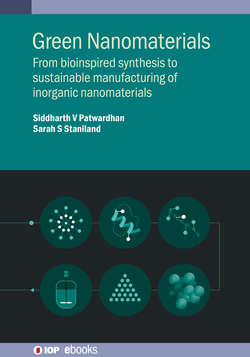Читать книгу Green Nanomaterials - Siddharth Patwardhan - Страница 9
На сайте Литреса книга снята с продажи.
IOP Publishing Green Nanomaterials From bioinspired synthesis to sustainable manufacturing of inorganic nanomaterials Siddharth V Patwardhan and Sarah S Staniland Chapter 1 Green chemistry and engineering 1.1 Principles of green chemistry and engineering 1.1.1 Overview
ОглавлениеAt present, we are highly reliant on chemical processes because of the benefits they bring to us. Examples of sectors where chemical industry has impacted our lives include healthcare, transportation, communications and food, constituting total sales of around €1.5 trillion globally [1]. In recent times, society has become more aware and concerned about the negative environmental impact associated with chemical industry. As such, there have been wider legislative interventions in order to ensure greater control and monitoring of chemical processes. These changes have led to increasing pressure on the chemical industry to continue to deliver high value products in an economical fashion, while minimising or eliminating the adverse environmental burden. This new challenge has driven the development of green chemistry for sustainable chemical processing.
Sustainable development has been defined by the United Nations as ‘…meeting the needs of the present without compromising the ability of future generations to meet their own needs’ [2]. Further, the United States Environmental Protection Agency (EPA) has extended this definition to give birth to green chemistry where the main goal is to ‘promote innovative chemical technologies that reduce or eliminate the use or generation of hazardous substances in the design, manufacture and use of chemical products’ [3]. Related to this is green engineering, which pertains to the design, commercialisation and the use of processes and products in an economical fashion to minimise pollution and risks to health and the environment. Utilising these concepts, 12 principles of green chemistry have been formulated [4], which are shown in figure 1.1.
Figure 1.1. 12 principles of green chemistry, after [4]. Copyright of OUP 1998.
Applying these green and sustainable principles has the potential to address the challenges facing chemical industry, in balancing the high value of products against the environmental burden. A common perception is that green chemistry is costly and/or can lead to costly products, thus reducing the profit for industry. However, this is not always true. While there may be initial investment needed for the development of green technologies, which can replace existing processes, such changes can also lead to reduced costs of production and products. Besides, considering the long-term benefits of adopting green chemistry, initial costs can be offset. Some of these points and the 12 principles will be discussed further in chapters 4 and 5 with specific relevance to nanomaterials.
